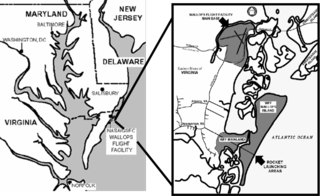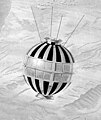
The Diamant rocket was the first exclusively French expendable launch system and at the same time the first satellite launcher not built by either the United States or USSR. As such, it has been referred to as being a key predecessor for all subsequent European launcher projects.

The Italian Space Agency is a government agency established in 1988 to fund, regulate and coordinate space exploration activities in Italy. The agency cooperates with numerous national and international entities who are active in aerospace research and technology.

Wallops Flight Facility (WFF) is a rocket launch site on Wallops Island on the Eastern Shore of Virginia, United States, just east of the Delmarva Peninsula and approximately 100 miles (160 km) north-northeast of Norfolk. The facility is operated by the Goddard Space Flight Center in Greenbelt, Maryland, and primarily serves to support science and exploration missions for NASA and other Federal agencies. WFF includes an extensively instrumented range to support launches of more than a dozen types of sounding rockets; small expendable suborbital and orbital rockets; high-altitude balloon flights carrying scientific instruments for atmospheric and astronomical research; and, using its Research Airport, flight tests of aeronautical research aircraft, including unmanned aerial vehicles.

The Scout family of rockets were American launch vehicles designed to place small satellites into orbit around the Earth. The Scout multistage rocket was the first orbital launch vehicle to be entirely composed of solid fuel stages. It was also the only vehicle of that type until the successful launch of the Japanese Lambda 4S in 1970.

The Luigi Broglio Space Center (BSC) located near Malindi, Kenya, is an Italian Space Agency (ASI) Spaceport. It was named after its founder and Italian space pioneer Luigi Broglio. Developed in the 1960s through a partnership between the Sapienza University of Rome's Aerospace Research Centre and the National Aeronautics and Space Administration (NASA), the BSC served as a spaceport for the launch of both Italian and international satellites (1967–1988). The center comprises a main offshore launch site, known as the San Marco platform, as well as two secondary control platforms and a communications ground station on the mainland.

Salto di Quirra is a restricted weapons testing range and rocket launch site near Perdasdefogu on the island of Sardinia. It is the largest military range in Italy, composed of 12,000 hectares of land owned by the Italian Ministry of Defence and one of the largest in operation within the European Union. Birth defects and cancer in the area have been blamed on weaponry used at the site.

Gaetano Arturo Crocco was an Italian scientist and aeronautics pioneer, the founder of the Italian Rocket Society, and went on to become Italy's leading space scientist. He was born in Naples.

Spaceflight began in the 20th century following theoretical and practical breakthroughs by Konstantin Tsiolkovsky, Robert H. Goddard, and Hermann Oberth, each of whom published works proposing rockets as the means for spaceflight. The first successful large-scale rocket programs were initiated in Nazi Germany by Wernher von Braun. The Soviet Union took the lead in the post-war Space Race, launching the first satellite, the first animal, the first human and the first woman into orbit. The United States would then land the first men on the Moon in 1969. Through the late 20th century, France, the United Kingdom, Japan, and China were also working on projects to reach space.

The Mid-Atlantic Regional Spaceport (MARS) is a commercial space launch facility located at the southern tip of NASA's Wallops Flight Facility on Wallops Island in Virginia, just east of the Delmarva Peninsula and south of Chincoteague, Virginia, United States. It is owned and operated by the Virginia Spaceport Authority.
Ariel was a British satellite research programme conducted between the early 1960s and 1980s. Six satellites were launched as part of the programme, starting with the first British satellite, Ariel 1, which was launched on 26 April 1962, and concluding with the launch of Ariel 6 on 2 June 1979. The launch of Ariel 1 made Britain the third country to have a satellite orbiting the Earth. The first four were devoted to studying the ionosphere, the remaining two to X-ray astronomy and cosmic-ray studies.

Launch Pad 0 (LP-0), also known as Launch Complex 0 (LC-0), or Launch Area 0 (LA-0), is a launch complex at the Mid-Atlantic Regional Spaceport (MARS) on Wallops Island, Virginia, in the United States. MARS is located adjacent to NASA's Wallops Flight Facility (WFF), which ran the launch complex until 2003. WFF continues to provide various support services to MARS launches under contract with the Commonwealth of Virginia.

San Marco 1, also known as San Marco A, was the first Italian satellite. Built in-house by the Italian Space Research Commission on behalf of the National Research Council, it was the first of five as part of the Italian-US San Marco programme.

Luigi Broglio, was an Italian aerospace engineer, airforce lieutenant colonel and dean of the school of aeronautical engineering at the University of Rome La Sapienza. Known as "the Italian von Braun", he is best known as the architect of the San Marco programme.
The space programme of Kenya has been largely shaped by Kenya's equatorial latitude, and has basis of existed foreign infrastructure and experience. The development of the programme started in May 2012.

Orbital-1, also known as Orb-1, was the second flight of the Orbital Sciences Cygnus cargo spacecraft, its second flight to the International Space Station (ISS) and the third launch of the company's Antares launch vehicle. The mission launched on 9 January 2014 at 18:07:05 UTC.

Orbital-3, also known as Orb-3, was an attempted flight of Cygnus, an automated cargo spacecraft developed by United States-based company Orbital Sciences, on 28 October 2014. The mission was intended to launch at 22:22:38 UTC that evening. This flight, which would have been its fourth to the International Space Station and the fifth of an Antares launch vehicle, resulted in the Antares rocket exploding seconds after liftoff.

Explorer S-56 was a NASA satellite launched on 4 December 1960, at 21:14 GMT as part of the Explorer program. The satellite was composed of a 3.66 m (12.0 ft) diameter inflatable sphere, and was intended to study the density of the upper atmosphere. The Scout X-1 rocket used to launch Explorer S-56 failed in flight, and the satellite never reached orbit.

The Virginia Spaceport Authority, formally better known as Virginia Space, is a political subdivision of the Commonwealth of Virginia headquartered in Norfolk, Virginia focused on bringing commercial spaceflight to Virginia and providing education in aerospace technologies across the Commonwealth. Created in 1995 as the Virginia Commercial Space Flight Authority (VCSFA) in the name of states' rights by the Virginia General Assembly, Virginia Space owns and operates the Mid-Atlantic Regional Spaceport (MARS) on Wallops Island, located within the Wallops Flight Facility. The subdivision assumed its current name in April 2023.

NG-15, previously known as OA-15, was the fifteenth launch of the Northrop Grumman robotic resupply spacecraft Cygnus and its fourteenth flight to the International Space Station (ISS) under the Commercial Resupply Services (CRS) contract with NASA. The mission launched on 20 February 2021 at 17:36:50 UTC. This is the fourth launch of Cygnus under the CRS-2 contract.
Carlo Buongiorno was an Italian aerospace engineer, first Director of the Italian Space Agency and professor at the Sapienza University, in Rome. He was a pivotal figure in the Italian space program.




















